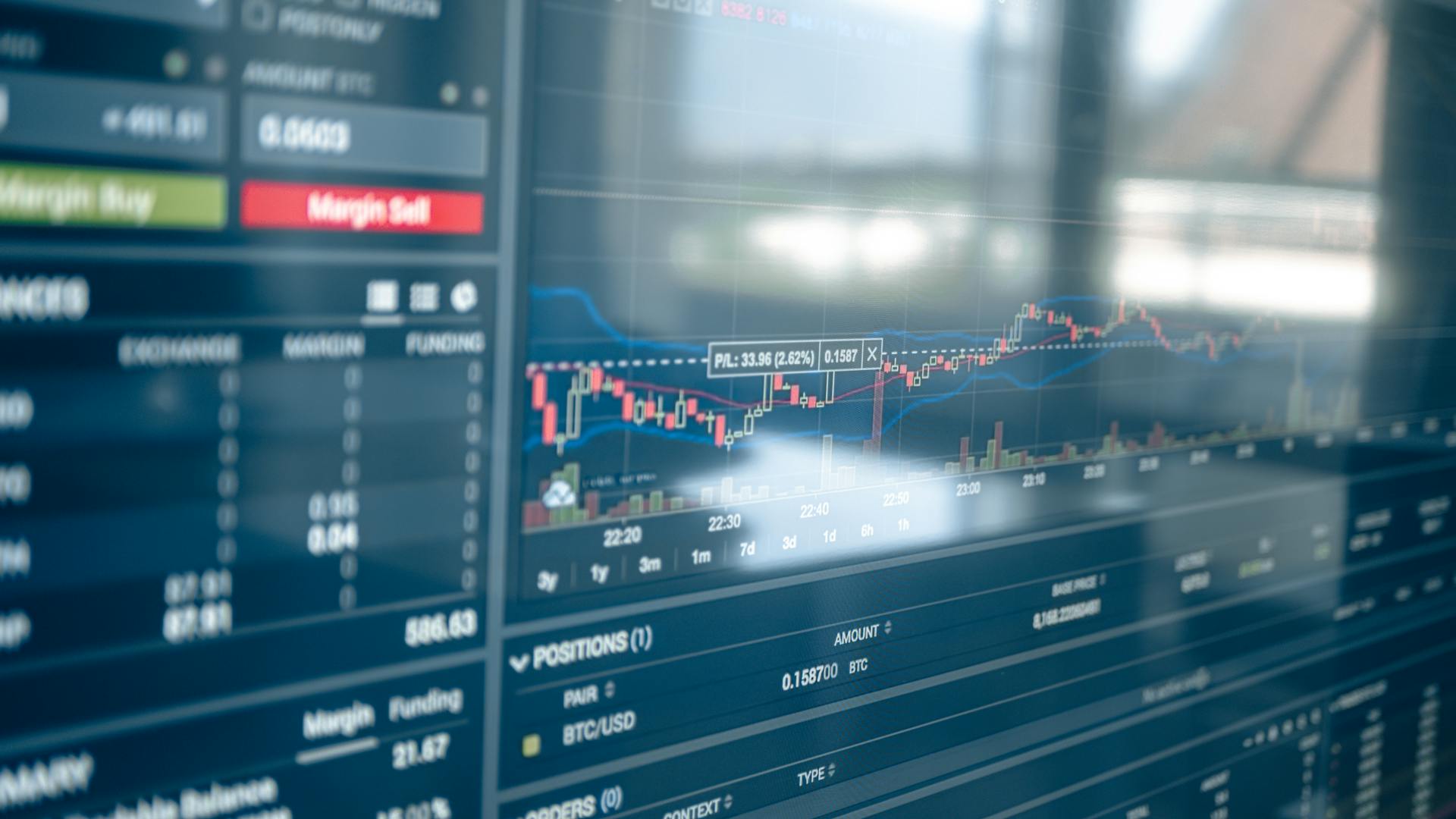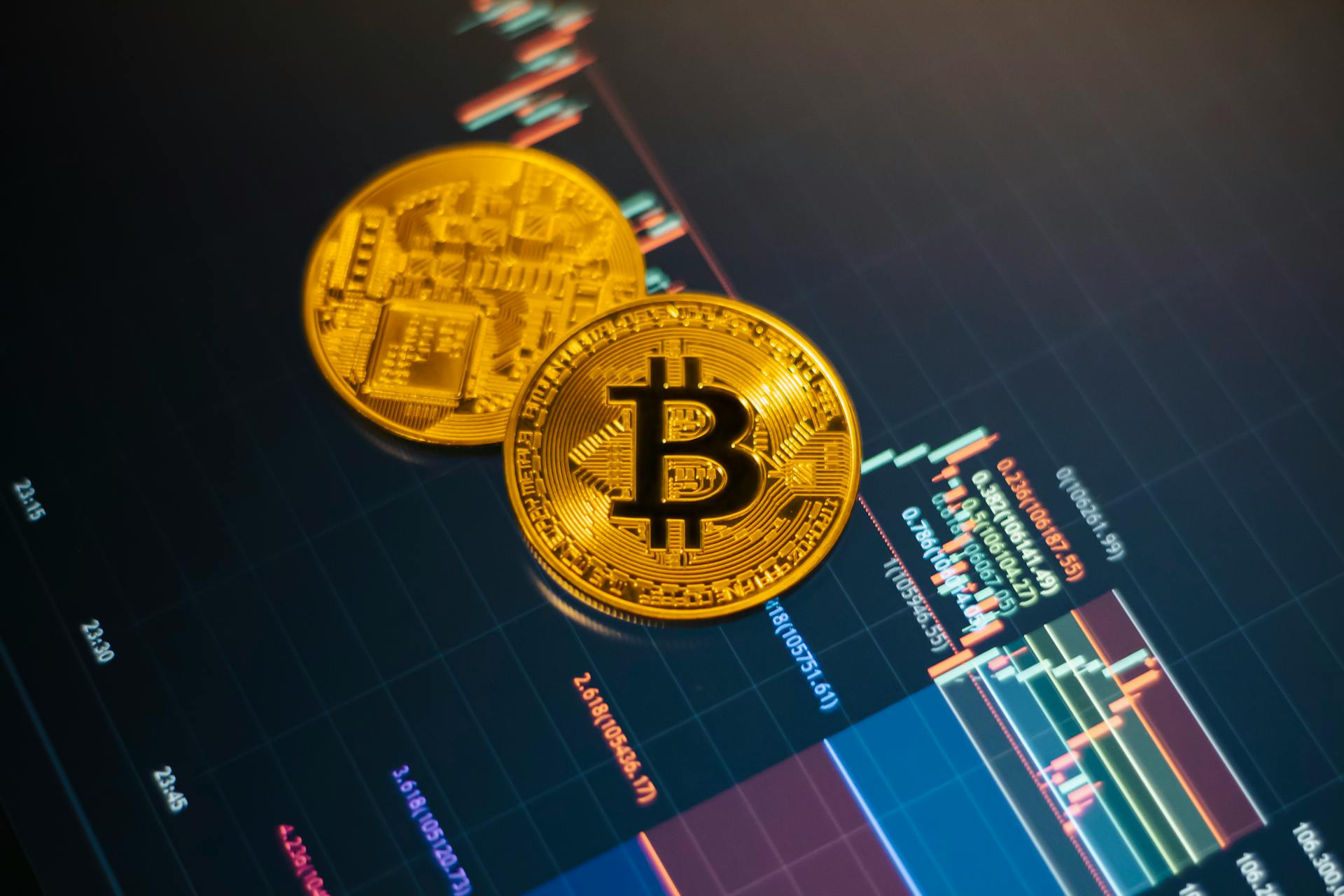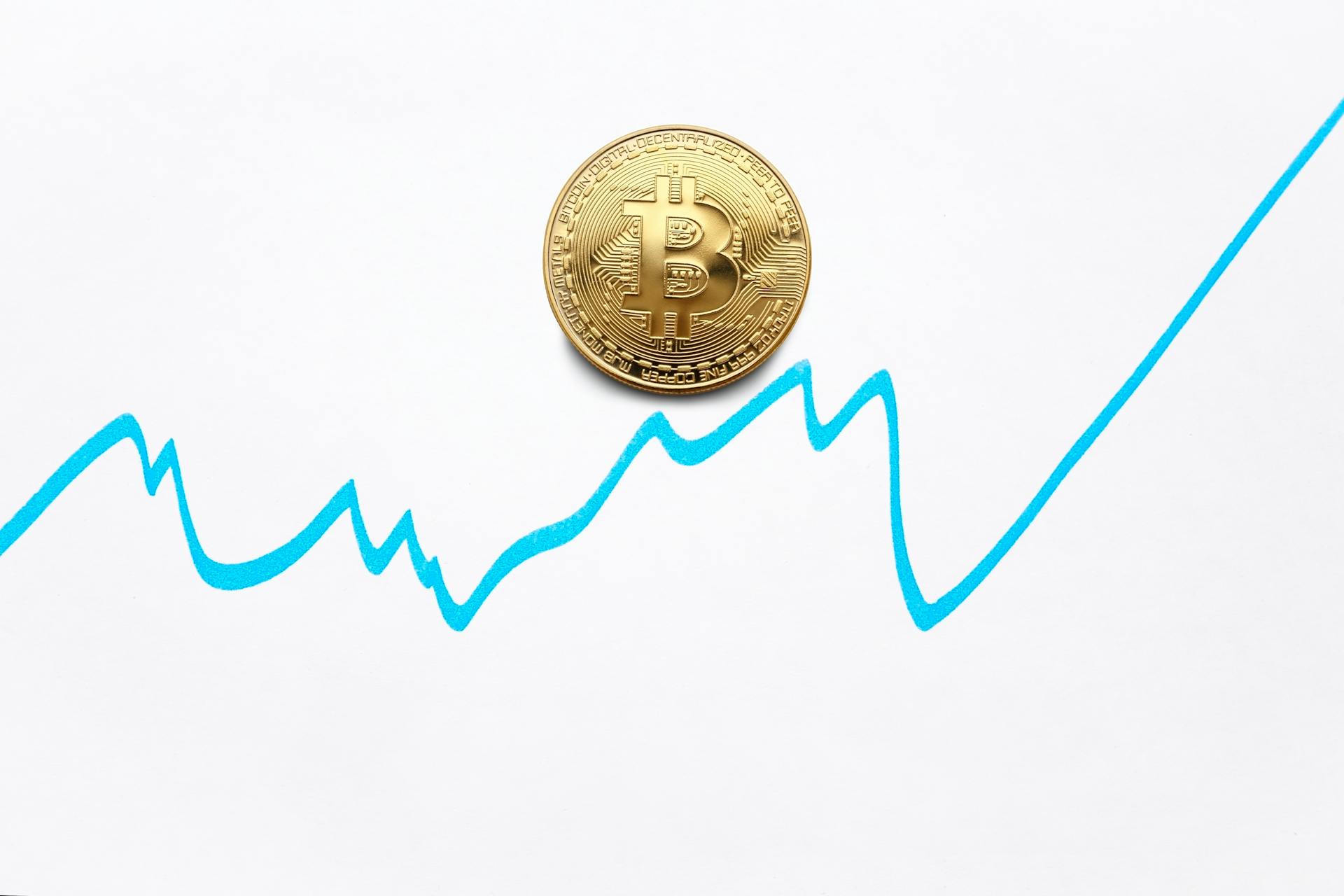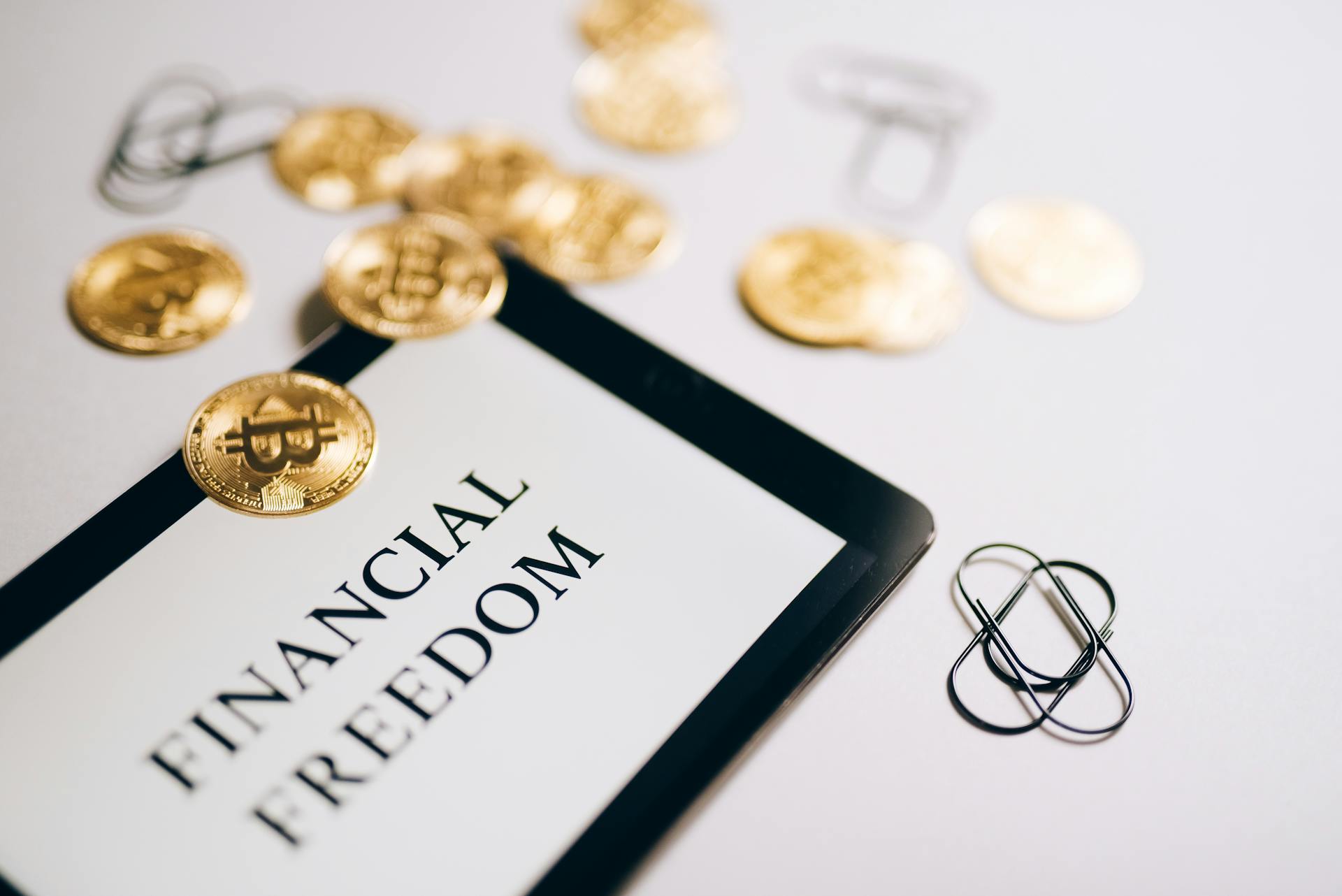
Crypto exchange listing fees can be a significant barrier for new projects seeking to gain visibility and liquidity in the market. These fees can range from $50,000 to $1 million or more, depending on the exchange.
Listing fees are typically non-refundable and can be a one-time payment or an ongoing fee. The listing process can take anywhere from a few weeks to several months.
Some exchanges offer different tiers of listing fees, with higher fees often resulting in more prominent listings and greater visibility. The listing fee is usually separate from other costs associated with trading on the exchange, such as transaction fees.
Exchanges may also offer additional services for a fee, such as market making or liquidity provision, which can further increase costs for new projects.
Explore further: What Crypto Exchange Has the Lowest Fees
What Are Fees?
Fees can be a significant cost for cryptocurrency projects looking to list their tokens on an exchange. Exchange listing fees vary based on the exchange, the token's popularity, and other factors.
Some exchanges charge high fees, which can be a barrier to entry for smaller projects. DEXs, on the other hand, often have lower barriers to entry and may not charge listing fees at all.
A different take: Crypto Wallet Fees
Types of Fees
Some cryptocurrency exchanges charge a flat fee for listing a token, regardless of the token's total value or the number of tokens being listed.
Other exchanges may charge a percentage of the total tokens or their value being listed as the listing fee, which can be more favorable for projects with a lower token value or smaller token supply.
Binance, the world's largest centralized exchange, has a unique listing fee system that doesn't charge a percentage of a project's token supply or impose a fixed fee.
A fresh viewpoint: Token Fi Crypto
Factors Influencing Fees
Crypto exchange fees vary significantly between exchanges, and several factors influence the costs you'll incur. Exchange size and popularity play a significant role, with larger exchanges charging more for listing fees and trading fees.
Token popularity and demand also impact listing fees, with more popular tokens or those with higher demand having higher listing fees. Project quality and reputation can also affect listing fees, with exchanges charging lower fees or waiving them entirely for projects that meet specific criteria.
Here are some specific factors that influence fees:
- Exchange Size and Popularity: Larger exchanges charge more for listing fees and trading fees.
- Token Popularity and Demand: More popular tokens have higher listing fees.
- Project Quality and Reputation: Exchanges charge lower fees or waive them for projects with a solid track record or recommendations from trusted sources.
Typically, the higher your trading volume and frequency, the lower the fees you'll pay. Maker fees can range from 0–0.2%, while taker fees can go up to 0.5% or higher, depending on the exchange and trading volume. Some exchanges offer a fixed percentage fee for both makers and takers, while others have a tiered system where fees decrease as trading volume increases.
If this caught your attention, see: Crypto Exchange Volume
User Location and Regulatory Environment
User location and regulatory environment play a significant role in determining fees for crypto exchange users. Regulatory compliance requirements can vary significantly from one region to another, impacting fee structures.
In some countries, strict regulations on crypto trading result in higher fees for users. For example, in the United States, exchanges must comply with stringent Know Your Customer (KYC) and Anti-Money Laundering (AML) regulations, increasing operational costs.
Higher fees are also imposed due to taxes on cryptocurrency trading. In India, cryptocurrency transactions are subject to a Goods and Services Tax (GST) of 30%, which exchanges pass on to users.
In contrast, countries with more favorable regulatory environments have lower fees for users. Japan, Singapore, and Switzerland are examples of such countries.
Worth a look: Crypto Exchange Margin Trading
Market Conditions
Market conditions can significantly impact the fees you pay on a crypto exchange. High demand for a cryptocurrency can lead to lower exchange fees, as exchanges try to attract more traders and capitalize on increased market activity.
Trading volume and liquidity improve during periods of high demand, making it a win-win for both traders and exchanges. This means you may be able to save on fees when trading popular cryptocurrencies.
Market volatility can also increase exchange fees, as exchanges take on more risk when adjusting to changing market conditions. High volatility can lead to more frequent and drastic price swings, making it riskier for exchanges to facilitate trades.
Conversely, low market volatility can result in lower exchange fees, as there is less risk involved in trading. Exchanges may also charge lower fees for trading stablecoins, which are designed to have a stable value and less volatility.
On a similar theme: When Was Crypto Currency Invented
Trade Volumes and Frequency
Trade volumes and frequency play a significant role in determining the fees you'll pay on a crypto exchange. Exchanges want to incentivize high-volume traders to continue trading on their platforms, so they offer lower fees to attract and retain these traders.

High-volume traders bring in more liquidity to the market, which benefits the exchange and its users. As a result, exchanges often offer tiered fee structures based on trading volume.
For instance, a crypto exchange may have maker fees of 0.25% for traders with less than $50,000 in trading volume per month, but decrease them to 0.15% for those with over $1 million in trading volume. This means that traders with higher trading volumes can save money on fees.
Here's a breakdown of how trading volume can impact fees:
As you can see, the higher your trading volume, the lower your fees will be. This is a win-win for both you and the exchange, as you get to save money on fees and the exchange gets to benefit from increased liquidity.
Listing Process
The listing process for crypto exchanges can be a lengthy and complex one. You'll need to review all the requirements listed on each target exchange and compile all the necessary information to complete the submission process.
Decentralized exchanges have a simpler listing process, involving fewer steps and formalities. Centralized exchanges, on the other hand, have a much more rigorous process, often with 70+ questions to answer.
Here are some typical crypto project application requirements that you'll need to gather:
- Project Details: Name, Coin Ticker, Website, token address, number of holders, one sentence pitch
- Purpose, pain points, target industry and target users, project history, long term vision, detailed quarterly roadmap for next few quarters, top competitors
- Whitepaper including ICO, Management Team (plus their background) & Project Scope
- Nature of the project: currency, dApp, platform, protocol, stablecoin, DeFi, NFT, other
- Status of the project: MVP, Test Net or Main Net (& planned launch on main net)
- Signed NDA (e.g. in the case of trying to get listed on Binance)
- Token & tokenomics info: market cap, max supply, circulating supply, ERC-20 or BEP 20 standard or not, planned swaps to launch on mainnet, blockchain explorer link
- Token listing on CoinMarketCap
- Community, DAU, MAU, and links to social profiles (e.g. Twitter, Telegram, Discord, Slack, LIne, Reddit etc.), developer communities, and recent activities (e.g. bounties, hackathons, meetups etc.)
- Legal opinion produced by a top law firm on the status of the token/coin being/not being a security or another regulated financial instrument in the territory based on local legislation
- Team: core team info, previous/current project involvement, advisor info
- Legal entity review
- Security audit report conducted by 3rd party auditor (optional for some exchanges)
- Marketing activities planned post launch
- Acknowledgment that the crypto token/coin could be delisted with no refunds issued if the event happens (e.g. volume drop, misconduct)
- Partnership with a crypto market maker and liquidity provider
Step 1: Choosing the Right
Choosing the right cryptocurrency exchanges for listing is a crucial step in the process. With over 528 exchanges and 21.9k cryptocurrencies, it can be overwhelming to decide which ones to target.
Your goals and project questions should guide your decision. Consider factors such as the exchange's reputation, safety, and transparency about proof of reserves. Some exchanges, like Kraken and Binance, have audited reserves and listed their proof of reserves in a transparent manner.
You should also think about your budget and timeline. If you want to get listed quickly, a decentralized exchange like Uniswap might be the way to go. However, if you're willing to spend a significant amount on listing fees, you can target top-tier exchanges.
Consider reading: Delete Depop Listing

Here are some key factors to consider when choosing the right exchanges:
- Reputation
- Safety and transparency
- Budget for listing fees
- Timeline
- Target geographical market
- Support for your protocol
- Trading options (spot, margin, staking)
- Volume and wash trading
- Community management and customer service
- Decentralized or centralized exchanges
Keep in mind that some exchanges, like Binance, have a low success rate for listing applications. It's essential to do your research and examine volume, online reputation, and website traffic to minimize the risk of fraud and scams.
Step 2: Process
So you've decided to list your crypto project on an exchange, congratulations! You'll need to go through the listing process, which involves reviewing all the requirements listed on each target exchange.
Decentralized exchanges have a fairly simple listing process with fewer steps and formalities, but be warned, it's still a process. Centralized exchanges, especially top-tier ones, have a lot of eligibility and legal requirements to meet.
You'll need to compile all the information required to complete the submission process, which can be a lengthy form with 15-70+ questions. For example, Binance, Crypto.com, and Kraken have forms with this many questions.

Here are some typical crypto project application requirements:
- Project Details: Name, Coin Ticker, Website, token address, number of holders, one sentence pitch
- Purpose, pain points, target industry and target users, project history, long term vision, detailed quarterly roadmap for next few quarters, top competitors
- Whitepaper including ICO, Management Team (plus their background) & Project Scope
- Nature of the project: currency, dApp, platform, protocol, stablecoin, DeFi, NFT, other
- Status of the project: MVP, Test Net or Main Net (& planned launch on main net)
- Signed NDA (e.g. in the case of trying to get listed on Binance)
- Token & tokenomics info: market cap, max supply, circulating supply, ERC-20 or BEP 20 standard or not, planned swaps to launch on mainnet, blockchain explorer link
- Token listing on CoinMarketCap
- Community, DAU, MAU, and links to social profiles (e.g. Twitter, Telegram, Discord, Slack, LIne, Reddit etc.), developer communities, and recent activities (e.g. bounties, hackathons, meetups etc.)
- Legal opinion produced by a top law firm on the status of the token/coin being/not being a security or another regulated financial instrument in the territory based on local legislation
- Team: core team info, previous/current project involvement, advisor info
- Legal entity review
- Security audit report conducted by 3rd party auditor (optional for some exchanges)
- Marketing activities planned post launch
- Acknowledgment that the crypto token/coin could be delisted with no refunds issued if the event happens (e.g. volume drop, misconduct)
- Partnership with a crypto market maker and liquidity provider
Remember, gathering all the answers to the lengthy form will give you all the info you need to submit a listing application anywhere else.
How to List Assets
The listing process involves reviewing all the requirements listed on each target exchange and compiling all the necessary information. You'll need to complete a lengthy application form, which can range from 15 to 70+ questions, depending on the exchange.
Typical crypto project application requirements include project details, purpose, pain points, target industry, and target users. You'll also need to provide a whitepaper, including ICO information, management team background, and project scope. Additionally, you'll need to disclose the nature of your project, such as a currency, dApp, or platform.
To increase your chances of getting listed, it's essential to have a solid project history, a detailed quarterly roadmap, and a top-notch management team. You'll also need to provide information about your token, including market cap, max supply, circulating supply, and ERC-20 or BEP 20 standard.
Here's a breakdown of the typical crypto project application requirements:
- Project Details: Name, Coin Ticker, Website, token address, number of holders, one sentence pitch
- Purpose, pain points, target industry and target users, project history, long term vision, detailed quarterly roadmap for next few quarters, top competitors
- Whitepaper including ICO, Management Team (plus their background) & Project Scope
- Nature of the project: currency, dApp, platform, protocol, stablecoin, DeFi, NFT, other
- Status of the project: MVP, Test Net or Main Net (& planned launch on main net)
- Signed NDA (e.g. in the case of trying to get listed on Binance)
- Token & tokenomics info: market cap, max supply, circulating supply, ERC-20 or BEP 20 standard or not, planned swaps to launch on mainnet, blockchain explorer link
- Token listing on CoinMarketCap
- Community, DAU, MAU, and links to social profiles (e.g. Twitter, Telegram, Discord, Slack, LIne, Reddit etc.), developer communities, and recent activities (e.g. bounties, hackathons, meetups etc.)
- Legal opinion produced by a top law firm on the status of the token/coin being/not being a security or another regulated financial instrument in the territory based on local legislation
- Team: core team info, previous/current project involvement, advisor info
- Legal entity review
- Security audit report conducted by 3rd party auditor (optional for some exchanges)
- Marketing activities planned post launch
- Acknowledgment that the crypto token/coin could be delisted with no refunds issued if the event happens (e.g. volume drop, misconduct)
- Partnership with a crypto market maker and liquidity provider
Once you've compiled all the necessary information, you'll need to submit your application and wait for the exchange to review it. The review process can take anywhere from a few days to several weeks, depending on the exchange and the complexity of your application.
Marketing and Promotion
Marketing and Promotion is a crucial aspect of the listing process.
Some exchanges require additional fees for marketing or promoting the listed token, which can help increase the token's visibility on the platform and attract more traders.
These fees can vary from exchange to exchange, but they're an essential consideration when deciding whether to list your token.
By paying for marketing and promotion, you can reach a wider audience and potentially boost trading activity on your token.
Frequently Asked Questions
How much does Coinbase charge for listing?
No listing fees are charged by Coinbase to asset issuers. We keep our fees transparent and low, so you can focus on growing your business
What are Binance exchange listing fees?
Binance does not charge listing fees, unlike some other exchanges. However, listing fees on other exchanges, such as Coinbase, can be substantial, with quotes ranging from $30 million to $300 million.
Sources
Featured Images: pexels.com


